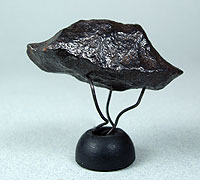Fascinatin' Crustaceans
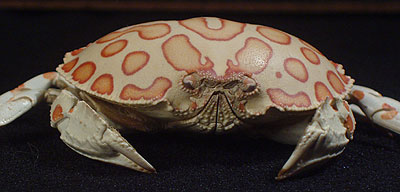
The Zymoglyphic Museum's Arthropod Division has recently expanded its Crabs of the World collection with a shipment from Conchology, Inc. of the Philippine Islands. The museum's original collection has been a miscellany of eBay, shell shop, and other purchases, not always with proper identification. A recent concerted effort for taxonomic accuracy in identifying its various specimens has been aided by a number of helpful folks at The Crustacean Society.
Crabs have an important place in Zymoglyphic culture. When dead, they often look as though they are just posing for a really long time, and so make excellent diorama characters. They are the stars in the traveling crustacean mini-diorama, as well as supporting actors in many of the museum's aquatic dioramas. They are nautical mechanical marvels, from the tight, interlocking parts of a box crab to the implausibly leggy spider crabs. Some, such as the fiddler crab, verge on becoming "eccentric contraptions", surreal beings whose very existence seems impossible. Some have great character, such as the leopard crab shown above.
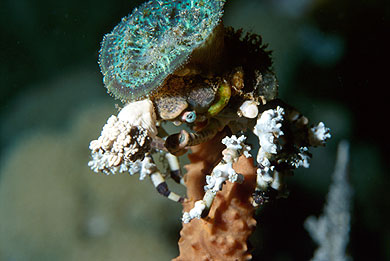
In previous entries, we have featured as "natural assemblage artists" the bowerbirds, who collect and arrange various objects to attract mates, and the Xenophora, shellfish which collect and arrange other shells on themselves. Decorator crabs take the latter idea further and make themselves into living, walking gardens. They cover themselves with a selection of living seaweed and plant-like animals, such as sponges, corals, and bryozoans. This is not a weed garden in the sense of just allowing things to grow on the carapace; the selections are carefully nipped and placed on specialized projections on the shell. The purpose is both camouflage and protection due to the poisonous nature of many of the selections. The festively decked-out crab shown here is a Cyclocoeloma tuberculata (photo from edge-of-reef.com).
If you are in the Seattle area and interested in crustaceans, there is an excellent collection at the shell museum in Port Gamble, a ferry ride across Puget Sound from Seattle.
Labels: Museum objects and collections, Natural art, Natural history
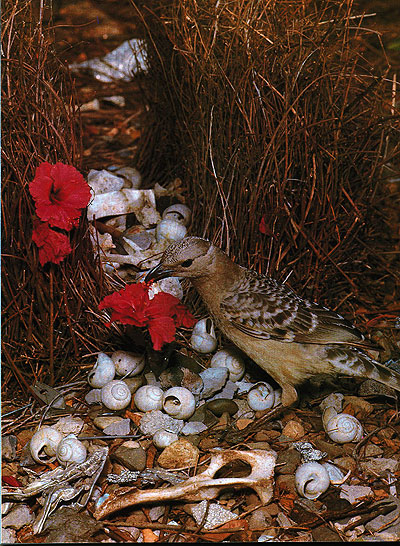 While some may question whether
While some may question whether 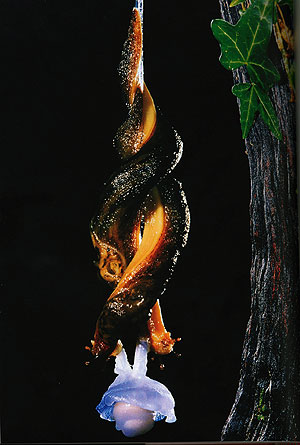
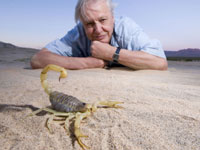 David Attenborough would make an excellent guide to the Zymoglyphic regions as well. He has great qualifications - he had a little museum when he was a boy, and now has huge collection of souvenirs from his travels. He is a perfect mixture of authoritativeness, enthusiasm, wonder, and a taste for the bizarre. A phrase he often uses is "and the strangest of all is this one...". He combines all that with the latest technical wizardry in closeup photography and has an engaging personal style. He is always on the scene, often windblown or out of breath, battling mosquitos to sneak up on some hapless creature. He keeps up with recent discoveries, so each series often includes some new odd animal, plant, or behavior that I have not heard about. He has covered a full range of biological and anthropological themes, and he has managed to contribute to science without having to specialize. He always has interesting ideas on the interconnectedness of things; not just describing some odd behavior, but explaining what forces have caused it to evolve that way. If he is not available for the job (as is likely), he can still serve as a role model!
David Attenborough would make an excellent guide to the Zymoglyphic regions as well. He has great qualifications - he had a little museum when he was a boy, and now has huge collection of souvenirs from his travels. He is a perfect mixture of authoritativeness, enthusiasm, wonder, and a taste for the bizarre. A phrase he often uses is "and the strangest of all is this one...". He combines all that with the latest technical wizardry in closeup photography and has an engaging personal style. He is always on the scene, often windblown or out of breath, battling mosquitos to sneak up on some hapless creature. He keeps up with recent discoveries, so each series often includes some new odd animal, plant, or behavior that I have not heard about. He has covered a full range of biological and anthropological themes, and he has managed to contribute to science without having to specialize. He always has interesting ideas on the interconnectedness of things; not just describing some odd behavior, but explaining what forces have caused it to evolve that way. If he is not available for the job (as is likely), he can still serve as a role model!